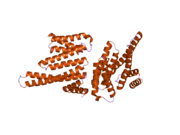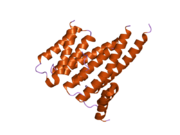Biology:YWHAB
From HandWiki
Short description: Protein-coding gene in the species Homo sapiens
 Generic protein structure example |
14-3-3 protein beta/alpha is a protein that in humans is encoded by the YWHAB gene.[1]
Function
This gene encodes a protein belonging to the 14-3-3 family of proteins, members of which mediate signal transduction by binding to phosphoserine-containing proteins. This highly conserved protein family is found in both plants and mammals. The encoded protein has been shown to interact with RAF1 and CDC25 phosphatases, suggesting that it may play a role in linking mitogenic signaling and the cell cycle machinery. Two transcript variants, which encode the same protein, have been identified for this gene.[2]
Interactions
YWHAB has been shown to interact with:
- BRAF,[3][4]
- C-Raf,[5][6][7][8][9][10]
- CD29,[11]
- CDC25A,[5]
- CDC25B,[5][12]
- Cbl gene,[13]
- EPB41L3,[3][14]
- HDAC4[15]
- KCNK3,[16]
- MAPK7,[17]
- PTPN3,[18]
- PRKCZ,[8]
- RPS6KA1,[19]
- TESK1,[20]
- TNFAIP3,[10] and
- WEE1.[21]
See also
References
- ↑ "Assignment of the human genes encoding 14,3-3 Eta (YWHAH) to 22q12, 14-3-3 zeta (YWHAZ) to 2p25.1-p25.2, and 14-3-3 beta (YWHAB) to 20q13.1 by in situ hybridization". Genomics 33 (1): 149–50. June 1996. doi:10.1006/geno.1996.0176. PMID 8617504.
- ↑ "Entrez Gene: YWHAB tyrosine 3-monooxygenase/tryptophan 5-monooxygenase activation protein, beta polypeptide". https://www.ncbi.nlm.nih.gov/sites/entrez?Db=gene&Cmd=ShowDetailView&TermToSearch=7529.
- ↑ 3.0 3.1 "Large-scale mapping of human protein-protein interactions by mass spectrometry". Mol. Syst. Biol. 3: 89. 2007. doi:10.1038/msb4100134. PMID 17353931.
- ↑ "Cell type-specific regulation of B-Raf kinase by cAMP and 14-3-3 proteins". J. Biol. Chem. 275 (41): 31921–9. October 2000. doi:10.1074/jbc.M003327200. PMID 10931830.
- ↑ 5.0 5.1 5.2 "14-3-3 proteins associate with cdc25 phosphatases". Proc. Natl. Acad. Sci. U.S.A. 92 (17): 7892–6. August 1995. doi:10.1073/pnas.92.17.7892. PMID 7644510. Bibcode: 1995PNAS...92.7892C.
- ↑ "Novel raf kinase protein-protein interactions found by an exhaustive yeast two-hybrid analysis". Genomics 81 (2): 112–25. February 2003. doi:10.1016/S0888-7543(02)00008-3. PMID 12620389.
- ↑ "Role of the 14-3-3 C-terminal loop in ligand interaction". Proteins 49 (3): 321–5. November 2002. doi:10.1002/prot.10210. PMID 12360521.
- ↑ 8.0 8.1 "14-3-3 isotypes facilitate coupling of protein kinase C-zeta to Raf-1: negative regulation by 14-3-3 phosphorylation". Biochem. J. 345 (2): 297–306. January 2000. doi:10.1042/0264-6021:3450297. PMID 10620507.
- ↑ "Isoform-specific localization of A-RAF in mitochondria". Mol. Cell. Biol. 20 (13): 4870–8. July 2000. doi:10.1128/MCB.20.13.4870-4878.2000. PMID 10848612.
- ↑ 10.0 10.1 "14-3-3 proteins associate with A20 in an isoform-specific manner and function both as chaperone and adapter molecules". J. Biol. Chem. 271 (33): 20029–34. August 1996. doi:10.1074/jbc.271.33.20029. PMID 8702721.
- ↑ "Identification of a novel interaction between integrin beta1 and 14-3-3beta". Oncogene 20 (3): 346–57. January 2001. doi:10.1038/sj.onc.1204068. PMID 11313964.
- ↑ "Specific interaction between 14-3-3 isoforms and the human CDC25B phosphatase". Oncogene 19 (10): 1257–65. March 2000. doi:10.1038/sj.onc.1203419. PMID 10713667.
- ↑ "A c-Cbl yeast two hybrid screen reveals interactions with 14-3-3 isoforms and cytoskeletal components". Biochem. Biophys. Res. Commun. 240 (1): 46–50. November 1997. doi:10.1006/bbrc.1997.7608. PMID 9367879.
- ↑ "The 4.1/ezrin/radixin/moesin domain of the DAL-1/Protein 4.1B tumour suppressor interacts with 14-3-3 proteins". Biochem. J. 365 (Pt 3): 783–9. August 2002. doi:10.1042/BJ20020060. PMID 11996670.
- ↑ "Regulation of histone deacetylase 4 and 5 and transcriptional activity by 14-3-3-dependent cellular localization". Proc. Natl. Acad. Sci. U.S.A. 97 (14): 7835–40. July 2000. doi:10.1073/pnas.140199597. PMID 10869435. Bibcode: 2000PNAS...97.7835G.
- ↑ "Forward transport. 14-3-3 binding overcomes retention in endoplasmic reticulum by dibasic signals". Cell 111 (4): 577–88. November 2002. doi:10.1016/S0092-8674(02)01040-1. PMID 12437930.
- ↑ "14-3-3beta binds to big mitogen-activated protein kinase 1 (BMK1/ERK5) and regulates BMK1 function". J. Biol. Chem. 279 (10): 8787–91. March 2004. doi:10.1074/jbc.M310212200. PMID 14679215.
- ↑ "Serine phosphorylation-dependent association of the band 4.1-related protein-tyrosine phosphatase PTPH1 with 14-3-3beta protein". J. Biol. Chem. 272 (43): 27281–7. October 1997. doi:10.1074/jbc.272.43.27281. PMID 9341175.
- ↑ "14-3-3beta is a p90 ribosomal S6 kinase (RSK) isoform 1-binding protein that negatively regulates RSK kinase activity". J. Biol. Chem. 278 (20): 18376–83. May 2003. doi:10.1074/jbc.M208475200. PMID 12618428.
- ↑ "Binding of 14-3-3beta regulates the kinase activity and subcellular localization of testicular protein kinase 1". J. Biol. Chem. 276 (46): 43471–81. November 2001. doi:10.1074/jbc.M104620200. PMID 11555644.
- ↑ "Binding of 14-3-3beta to the carboxyl terminus of Wee1 increases Wee1 stability, kinase activity, and G2-M cell population". Cell Growth Differ. 11 (4): 211–9. April 2000. PMID 10775038.
Further reading
- "Partner molecules of accessory protein Vpr of the human immunodeficiency virus type 1". DNA Cell Biol. 23 (4): 193–205. 2004. doi:10.1089/104454904773819789. PMID 15142377. https://zenodo.org/record/1235217.
- "Human immunodeficiency virus type-1 accessory protein Vpr: a causative agent of the AIDS-related insulin resistance/lipodystrophy syndrome?". Ann. N. Y. Acad. Sci. 1024: 153–67. 2004. doi:10.1196/annals.1321.013. PMID 15265780. Bibcode: 2004NYASA1024..153K. https://zenodo.org/record/1235880.
- "New insights into potential functions for the protein 4.1 superfamily of proteins in kidney epithelium". Front. Biosci. 11: 1646–66. 2006. doi:10.2741/1911. PMID 16368544. https://digital.library.unt.edu/ark:/67531/metadc892527/.
 |



